More Than a Mommy Blog
Published on
November 04, 2014
By Kari
Project Manager
Blogging. What do you think of: Mommy bloggers? Cat pictures? People who rant? Duck-faced, 20-something “selfies”? Although these kinds of blogs and bloggers do exist, blogging as an industry is making a big splash in the world of marketing.
Full disclosure: I love reading blogs. I have been following a handful of them for a couple of years now and have witnessed them move, get pregnant, have babies, make career changes and go through some sad times. Some of these bloggers I probably trust more than my actual friends. Don’t believe me? Well, it seems that I am not alone because the world of blogging has grown exponentially over the past couple of years, and brands should pay close attention. This is changing the world of advertising.
Although blogs, or personal home pages as they were referred to in their early years of existence, have been around almost since the start of the Internet, they really started to grow in popularity with political blogs in the early 2000s. These early blogs were mostly about current events and pop culture, and were a jab on news outlets to get stories out to the public. With the launch of major blogging platforms and an increased interest in how-to blogs, blogging became mainstream by the mid-2000s and has grown ever since.
Today, there are blogs about nearly every subject – from weddings and fashion to home décor, music, travel and more. Bloggers are even making quite a bit of money from their posts, especially in the fashion industry where companies are really capitalizing on their blogger relationships. American designer Rebecca Minkoff allegedly paid Aimee Song (Song of Style) $5,000 to take one photo of herself wearing an outfit from the designer’s new denim line. Can you believe $5,000 for one picture? To her credit, Aimee has 1.58 million followers on her blog and 1.8 million followers on Instagram. One of her Instagram posts alone garnered more than 27,000 likes. Sounds like that was $5,000 well spent.
And it’s not just posts on which these bloggers are capitalizing. Blogger appearance fees in the U.S. start at $10,000 and can go as high as $50,000. According to top fashion publicist Alison Brod, brands are spending money on popular bloggers because “a devoted fanbase hanging on a blogger’s every recommendation ‘can get as many hits as a feature in InStyle magazine.’”
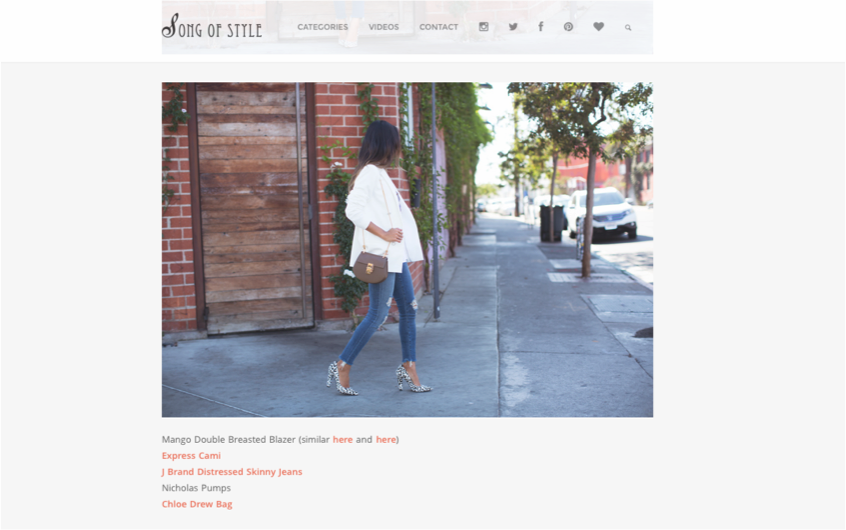
Photo: Aimee Song (Song of Style)
And just to prove how effective these blog posts have been, Blair Eadie of Atlantic-Pacific One has 479,000 followers on her blog and 515,000 followers on Instagram. Blair’s #OOTO (“outfit of the day”) pictures receive more than two million page views a month. On one occasion, she posted a photo on her blog of herself wearing a striped ASOS Peter Pan dress, and by the next morning thousands of Blair’s readers had clicked the link sending them to ASOS’ page. Eighty-three of her followers bought that exact dress just from one post! Blair was able to receive a commission based off the number of clicks from her blog to the ASOS page, and ASOS was able to reach thousands just from one blog post.
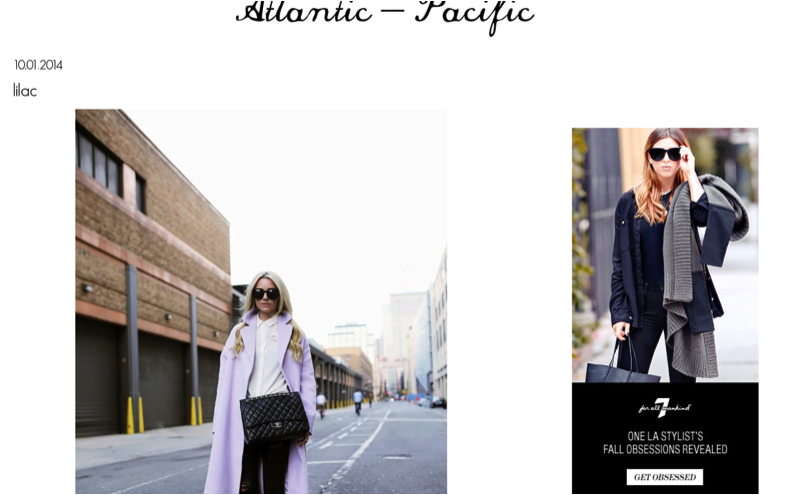
Photo: Blair Eadie (Atlantic-Pacific)
So is blogging an effective form of advertising? Absolutely! Followers of different bloggers develop a trust in their bloggers that banner ads and TV commercials just can’t re-create.
Readers love to see real-life people doing DIY projects or wearing a dress that they saw in the store. They like to see what it looks like on a real person without the retouching that goes on most of the time within ads. People like to know that a real person completed this DIY project, and it turned out well. Because of this, blog followers are clicking from these posts to retailers’ sites, and that is something that a banner ad can’t duplicate as effectively. There is a trust among the blogging community that can’t be replicated.
There are many ways that companies are being featured in blog posts. Some bloggers state at the beginning or end of their posts that it is being sponsored by a certain brand. For example, Kendi Skeen from Kendi Everyday wrote a post about her hair color that was sponsored by L’Oréal. In the post, she mentions that she used a L’Oréal product for touch-ups to her hair color and shows that the product was easy to use. She incorporated interesting and witty content before getting into the product to create an authentic story and to add her personality to something that can be perceived by users as inauthentic.
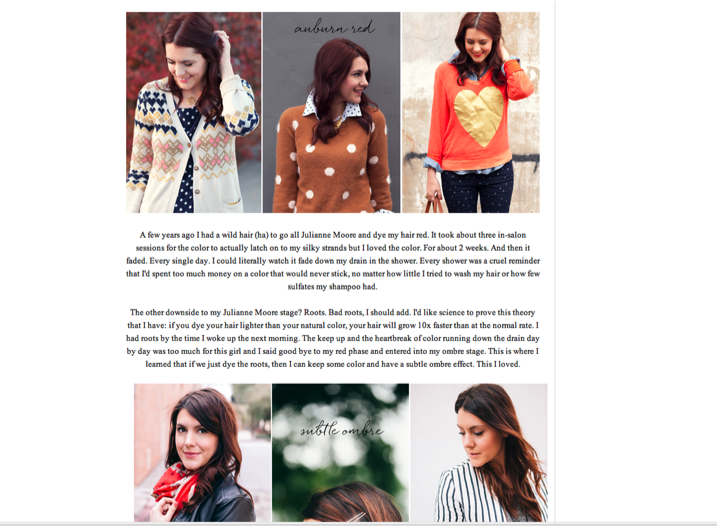
Photo: Kendi Skeen (Kendi Everyday) – L’Oréal Sponsorship
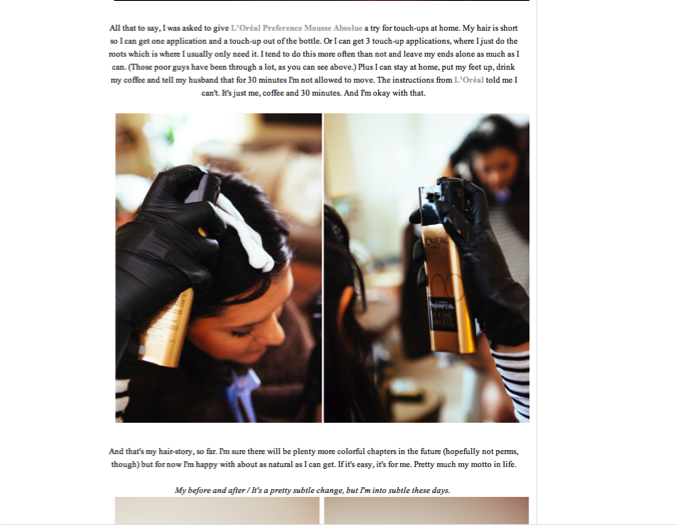
Photo: Kendi Skeen (Kendi Everyday) – L’Oréal Sponsorship
Another example is a Dove sponsorship with Emily Schuman from Cupcakes and Cashmere. She wrote a “Travel Prep” post about essentials that she packs when she goes on a trip. This list included products (one of them was Dove) and plenty of packing tips. On the rails of her site, there is a Dove rich media ad unit featuring the sponsorship with Dove. Some posts have had rich media or standard Flash ad units featured in tandem to further incorporate the brand into the site.

Photo: Emily Schuman (Cupcakes and Cashmere) – Dove Sponsorship
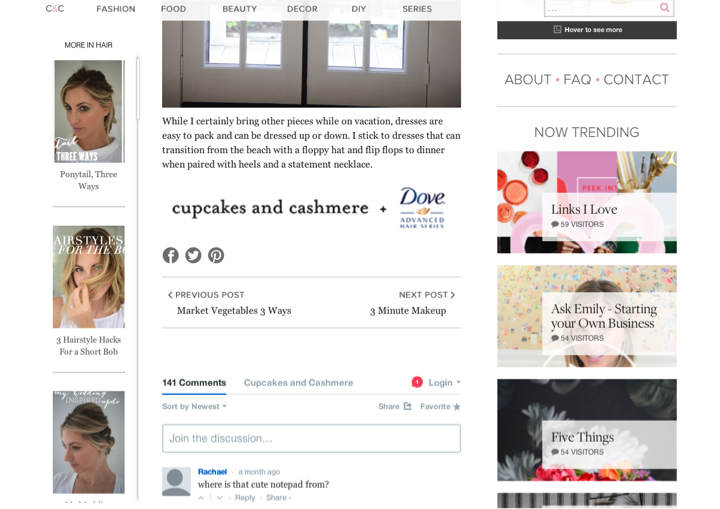
Photo: Emily Schuman (Cupcakes and Cashmere) – Dove Sponsorship
Currently, I am working on a Home Depot and Home Decorators Collection collaborative campaign that features bloggers who use The Home Depot and Home Decorators Collection products to redesign a room. The first room and blog post in the campaign went live a couple of weeks ago. The campaign uses rich media units and digital video to drive views of the room makeover videos in addition to the blog posts themselves.
The first blogger being featured is Kristin Jackson from The Hunted Interior. She redesigned a living room with products from The Home Depot and Home Decorators Collection. The video captures the room being redone from start to finish. There are also several how-to videos that show viewers how she installed the electric fireplace or styled the coffee table.
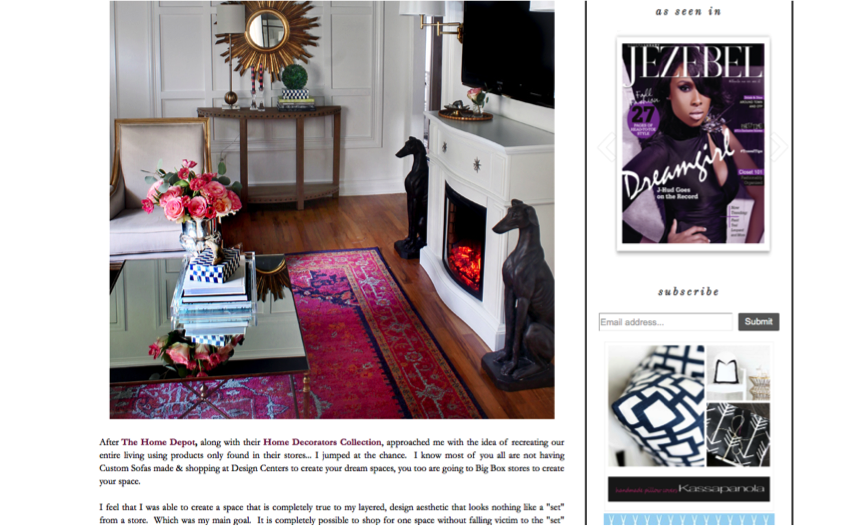
Photo: Kristin Jackson (The Hunted Interior) – The Home Depot Sponsorship

Photo: Kristin Jackson (The Hunted Interior) – The Home Depot Sponsorship
Since this campaign just launched a couple of weeks ago, we are still waiting on analytics. However, Kristin’s first post has garnered over 100 comments already, with her followers loving the room and saying that they have visited the Home Decorators Collection website. And just think of all the views the post has gotten with people who don’t comment. The YouTube video of the overall room transformation has almost 9,000 views.
All in all, blogger content should be taken into consideration when developing campaigns. Based off the numbers alone, readers are clicking through to brand pages and purchasing products from blogger content. The Instagram tool for bloggers, RewardStyle’s LiketoKnow.it, has over 1,300 active bloggers and generated $1 million in sales for RewardStyle affiliated retailers and brands in the three months since its launch in January 2014.
Numbers aside, from personal experience, I take what the bloggers I follow say to heart. I trust their opinions. These bloggers have quite a bit of leverage when it comes to the products they use. It is this personal connection that has changed the marketing landscape through sponsored content and affiliate marketing. Will your brand get on board or miss the opportunity?
For more on Kristin’s redesigned living room, click here. And to watch Kristin’s redesign and get some how-to help, click here.
To get acquainted with my blogging “friends,” visit:
And you can check out my blog here (shameless plug!).
TL;DR
Resources
The Click Clique
Texas MonthlyThe Rise of the Power Blogger
New York PostSong of Style
Song of StyleAtlantic-Pacific
Atlantic-PacificKendi Everyday
Kendi EverydayCupcakes and Cashmere
Cupcakes and CashmereThe Hunted Interior
The Hunted InteriorLIKEtoKNOW.it
LIKEtoKNOW.it